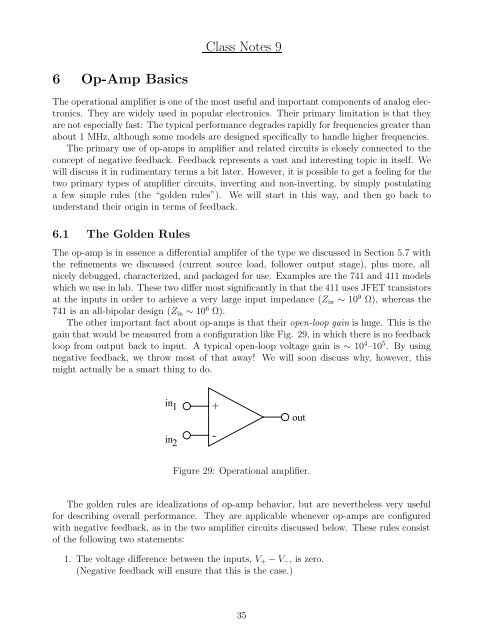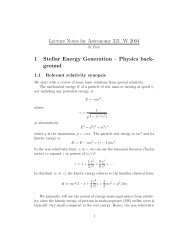Lecture Notes for Analog Electronics - The Electronic Universe ...
Lecture Notes for Analog Electronics - The Electronic Universe ...
Lecture Notes for Analog Electronics - The Electronic Universe ...
Create successful ePaper yourself
Turn your PDF publications into a flip-book with our unique Google optimized e-Paper software.
6 Op-Amp Basics<br />
Class <strong>Notes</strong> 9<br />
<strong>The</strong> operational amplifier is one of the most useful and important components of analog electronics.<br />
<strong>The</strong>y are widely used in popular electronics. <strong>The</strong>ir primary limitation is that they<br />
are not especially fast: <strong>The</strong> typical per<strong>for</strong>mance degrades rapidly <strong>for</strong> frequencies greater than<br />
about 1 MHz, although some models are designed specifically to handle higher frequencies.<br />
<strong>The</strong> primary use of op-amps in amplifier and related circuits is closely connected to the<br />
concept of negative feedback. Feedback represents a vast and interesting topic in itself. We<br />
will discuss it in rudimentary terms a bit later. However, it is possible to get a feeling <strong>for</strong> the<br />
two primary types of amplifier circuits, inverting and non-inverting, by simply postulating<br />
a few simple rules (the “golden rules”). We will start in this way, and then go back to<br />
understand their origin in terms of feedback.<br />
6.1 <strong>The</strong> Golden Rules<br />
<strong>The</strong> op-amp is in essence a differential amplifer of the type we discussed in Section 5.7 with<br />
the refinements we discussed (current source load, follower output stage), plus more, all<br />
nicely debugged, characterized, and packaged <strong>for</strong> use. Examples are the 741 and 411 models<br />
which we use in lab. <strong>The</strong>se two differ most significantly in that the 411 uses JFET transistors<br />
at the inputs in order to achieve a very large input impedance (Zin ∼ 10 9 Ω), whereas the<br />
741 is an all-bipolar design (Zin ∼ 10 6 Ω).<br />
<strong>The</strong> other important fact about op-amps is that their open-loop gain ishuge. Thisisthe<br />
gain that would be measured from a configuration like Fig. 29, in which there is no feedback<br />
loop from output back to input. A typical open-loop voltage gain is ∼ 10 4 –10 5 . By using<br />
negative feedback, we throw most of that away! We will soon discuss why, however, this<br />
might actually be a smart thing to do.<br />
in 1<br />
in 2<br />
+<br />
-<br />
out<br />
Figure 29: Operational amplifier.<br />
<strong>The</strong> golden rules are idealizations of op-amp behavior, but are nevertheless very useful<br />
<strong>for</strong> describing overall per<strong>for</strong>mance. <strong>The</strong>y are applicable whenever op-amps are configured<br />
with negative feedback, as in the two amplifier circuits discussed below. <strong>The</strong>se rules consist<br />
of the following two statements:<br />
1. <strong>The</strong> voltage difference between the inputs, V+ − V−, is zero.<br />
(Negative feedback will ensure that this is the case.)<br />
35













